Text
Ork gender
I saw another meme.

I have a little bit more time for this one but it's still wrong. Disregarding the fact that the concept of non-binary gender identity requires a notion of a binary gender model to reject so Tyranids at least are no more non-binary than my cat (or the insects that the hive structure is clearly based on). Um, Orks are more complicated.
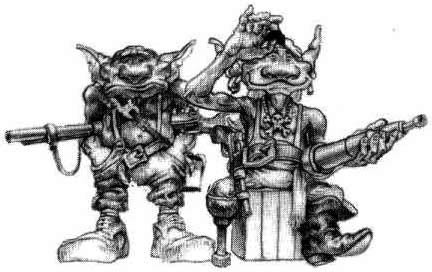
It doesn't follow that because orks in particular reproduce asexually they therefore have no concept of gender, any more than the human model of gender is an inevitable result of us reproducing sexually. Gender is a system by which humans attribute social significance to physical differences. Orks do this, but they don't do it the same way humans do. Ork gender is quaternary and includes orks, gretchin, snotlings and squigs. All these things are the same species, they're produced through the same spore-based reproductive process, but they exhibit physical differences and ork society attributes social differences based on those physical differences. That is gender.

So uh, orks are non-binary because their gender is quaternary, but that's not how we understand non-binary gender. Anyway.
Humans imposed the human model of sex onto bees and ants and decided that any of these organisms that don't contribute to sexual reproduction are female. The Tyranid hive structure is based on those insects so it's likely that there are organisms within the hive fleet that are responsible for the reproduction bit and chances are the majority of Tyranid organisms don't contribute. Undoubtedly some Magos Biologis has come to exactly the same conclusion about Tyranids and called everything from termagants up to bio-titans Female. Except genestealers. They probably wrote a whole thesis about the ovipositor called Sexing the Genestealer and concluded that Genestealers are male.
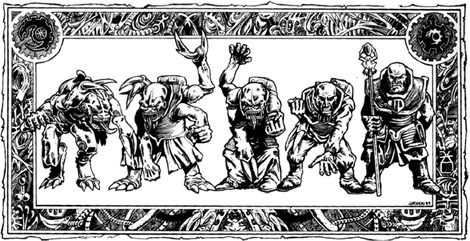
19 notes
·
View notes
Text
Space Marines are not your friend Part II

I keep thinking about this, and apparently a lot of other people keep thinking about this, because the conversation keeps happening. I think I didn't get it quite right the first time round, which is normal and we should embrace being wrong and changing our minds with new information.
So, sometimes you say the Imperium is Fascist and you learn form some dude online that actually they're a dictatorial theocracy or something. This is called splitting hairs but I think there's potential here for a more interesting conversation. It may come as a surprise but Warhammer 40,000, a game about spending whole Sunday afternoons moving little toy soldiers and tanks around on your dining room table with lore written by a whole bunch of different nerds over the last 35 years doesn't have a coherent political narrative.
We're not going to get the answers we're looking for by going over every bit of lore with a fine-toothed comb. Also please don't ask me to do that, some of the writing is really terrible. I've talked before in, I guess, Part I about how Warhammer 40,000 draws on the aesthetics of Fascism and I think this is what's really important. It really doesn't matter if the Imperium fulfils all of Umberto Eco's characteristics of Fascism or if you can find some other political ideology that you think fits better. The fact is that Warhammer 40,000 is a piece of largely visual media that draws on the imagery of Fascism, the same way it draws on the imagery of Feudalism and the Catholic and Orthodox churches.

There's a lot of talk lately about how people like Rick Priestly and Brian Ansell (may he rest in peace) and Richard Haliwell weren't really trying to make statements with their games but just wanted to sell miniatures, and they borrowed liberally from things like 2000AD because it was cool. I think that in itself says something about the game's ideology. It was developed and written in the context of Thatcherite Britain and I wonder if in that context there was an idea that it wasn't necessary to have the thing make political sense (and maybe that's naïve in hindsight, idk?). I don't know for sure but I wonder if 40K comes out of a time when you could be like "hey these cops are Fascists" and wouldn't need to expand on that. People would just get that you were painting in braod strokes and wouldn't demand that you prove that their brutality wasn't justified. I think it's fair to say the writers didn't foresee how big their game would get, or its popularity among military bros, or the rise of Fascism in the Anglosphere in the 2010s.

So, what do we do with this? I think it's important to recognise two things. Firstly, the Imperium isn't just a Fascist state. It's also a Theocracy, and Feudal. More than one of these things can be true. But secondly, we tend to assume our political concepts are universal and timeless. They're not. Here's an interview where Corey Robin situates the Left and Right historically for Adam Conover:
youtube
The point being that the Right isn't just authoritarian, it's a movement to reestablish the power of ruling classes in response to modern Democratic movements. Similarly, Fascism is a distinctly modern concept. It's an attempt to return to the idea, as identified by Robin above, that certain people should rule over everyone else, and it's a reaction against a move towards Democracy and people having freedom from authority.
So, political systems are historically constituted, I think it's fair to say that 38,000 years in the future our politics will be unrecognisable to us now. So like, does Fascism exist 38,000 years in the future, would it even be possible when you're trying to govern a billion worlds, is it "necessary" when state control of humanity is total, and Democracy, Socialism and Trade Unionism aren't even distant memories? Maybe the answer is it doesn't matter. I don't find that terribly satisfying.
The Imperium's political system isn't not Fascism. Rather, the writers of Warhammer 40,000 depicted a political system that's a sort of aggregate of political systems that are recognisable to a modern audience (and particularly pertinent to an audience living in Thatcherite Britain), and Fascism plays a major role in that aggregate.
So the upshot is, if you want to call it Fascism, you are correct, and if someone calls it Fascism and you want to say actually it's this extremely specific political thing you've just come up with to disprove them, consider shutting up.
22 notes
·
View notes
Text
The Emperor wasn't 12 feet tall
I see this meme a lot in my Instagram feed and it really grinds my gears:

Not because it seems to be trying to shame a fictional antagonist for being "wrong" (although that really doesn't help), but because whoever made it seems to have missed that depictions of the Emperor as superhuman are meant to be Imperial Propaganda.
Now, I realise I'm going to be fighting an uphill battle here because there seem to be people working for Games Workshop and producing their media who also missed that memo, and for a while now the studio has started producing actual depictions of the Emperor, and some of those depections show him as 12 feet tall and immortal. This might be controversial but I think what this shows is that Games Workshop don't understand Games Workshop's source material.
Here's a picture of the Emperor from the original Rogue Trader rulebook.

Even this is obviously meant to be a propaganda image, but here he looks like just a regular guy in armour, he's about the same size as the people around him. Not a superhuman, just a guy with an excess of hubris.
There's this literary construct called the unreliable narrator. When I studied literature we were given this short story to read called Bartleby the Scrivener. It's told from the point of view of an employer about a clerk who was apparently really difficult to manage. The subtext is that the narrator is trying to manipulate the reader to make themself look good.
For a long time, that's what Warhammer 40,000 did, the Imperium was made out to be an unreliable narrator. Stories about the Imperium's "glorious past" were told through the haze of ten thousand years of unending war, by an ecclesiastical class with a vested interest in keeping Imperial citizens committed to feeding the war machine. To the Imperium, the Great Crusade and the Horus Heresy serve the function of myths, more than history. I've gone on before about how important heroic figures like Siegfried and Perseus and Prometheus were to the Nazis. The Imperium, being a fictional state that draws on the aesthetics and ideology of Fascism, uses the figures of the Emperor and Primarchs the same way.
Basically what I'm saying is that when Imperial sources state that these people were twelve feet tall and immortal and could, um, turn a giant ork into a lightbulb on a whim, it's not because they had these powers, but because they've been ascribed these powers by their priesthood, who have total control over the flow of information in this setting.
And I get that this is hard, because most people don't get taught this stuff, and often people are probably looking for escapism from their fiction and why would the book I'm reading lie to me? But I think it really makes the setting more interesting if you look at it this way.
Also, I realise that since 2006 there have been books around that describe the Emperor, and they do show him as superhuman, and I think those depictions are based on the writers misunderstanding the material they're working from. I guess Tolkien wrote the existence of The Hobbit into Middle Earth as the Red Book of Westmarch so I can tell myself that the Horus Heresy novels are meant to be in-universe Imperial propaganda.
ADDENDUM: I need to add this because I've been reading about Perpetuals, which is apparently what the Emperor is since the Horus Heresy series was published. Apparently these individuals are human mutants that are both immortal and invincible. I remember Mechanicum heavily implying that the Emperor and St. George are the same person. Here's the problem with that. There are two themes that I think are really important in Warhammer 40,000. One is the Emperor's hubris, the idea was that he was playing god, genetically engineering monstrosities in the form of the primarchs. In the Greek tragic mould, it's this hubris that leads to his downfall. This kind of loses its sting if he's just trying to recreate what what he already is.
The other theme is the Imperium's superstition. This one is really the core of 40K. The Imperium has taken the corpse of a man who tried to rule the galaxy, told themselves he's not dead, plugged the corpse into a machine that "regenerates" him, and founded an intolerant, violent and expansionist religion around this husk. This theme changes significantly if the Emperor actually was as powerful as the Ecclesiarchy makes him out to be, and actually isn't dead, and has somehow been regenerating for the last 10,000 years. There's a question here about what would make an entity worthy of worship, or being called a god, and I probably shouldn't get into it but this is my blog so I'm going to. It seems like there's an assumption among some writers that if something can be rationally explained then it's not a god, because gods ipso facto don't exist. They've incorporated nonexistence into their definition of gods. This is where you get the idea that the Chaos gods aren't gods, because the setting explains their existince "rationally" with its internal logic (nevermind that there's nothing rational about the warp). If there were gods in a rational sense, then our model of the universe would have to change to accomodate them. I think the upshot of this is basically that if what the Horus Heresy novels claim about the Emperor is true, then the Ecclesiarchy are right and he is a god within the logic of the setting. That doesn't justify the genocide and expansionism, but maybe it does justify the worship, and that's something that I think takes away from the setting.
67 notes
·
View notes
Text
There's a scene in Fallout: New Vegas that I find really interesting in how it uses skill checks in dialogue. A merchant company, the Crimson Caravan, want to buy out one of their rivals, Cassidy Caravans, and they hire the player character to negotiate the deal. The player has likely already met the rival company's owner, Rose of Sharon Cassidy, by this point - in fact, it's entirely possible that she suggested they ask the Crimson Caravan for work in the first place.
Cass is propping up the bar at a truck stop on the border near the game's opening area. She's heard that her caravan has been destroyed in her absence - her employees killed and their wagons burned in an attack on the road - but she can't investigate because of a bureaucratic hold-up. The man in charge of the border post, Ranger Jackson, has halted all commercial traffic across the border because of dangers on the roads - wild animals, bandits, and enemy soldiers - that the authorities are struggling to get under control.
When the player brings the Crimson Caravan's offer to Cass, she refuses on principle. Her business may have effectively been destroyed, but she's too proud and too stubborn to sell her surname for any number of messes of pottage. Convincing her requires that the player employs one of either their Speech or Barter skills - there are two options for each, requiring either moderate or high investments of skill points. Skill and Barter are the game's two Charisma-based skills, and it's not uncommon for them to appear side-by-side like this, but here, they diverge in application.
The easier Speech option is simple - the player just reminds Cass that, if she sells the business, she won't be commercial traffic anymore, so she'll be able to get across the border. She's itching to get on the road again, so this convinces her. (She will ask the player to help Jackson clear the roads for the benefit of her fellow merchants, but this is a very simple quest that they likely already completed hours ago.)
The more challenging Speech check is to tell Cass that there's no way her business can survive, so it's her duty to do the merciful thing - shoot it in the head, bury it, and move on with her life. This, naturally, brings her close to socking the player in the jaw, but she sees the truth in it. She's been holding onto the forlorn hope that there might be something left to save, but she really has lost everything. This bypasses Jackson's quest - she just wants to walk out and not look back.
The Barter options approach things differently - from the Speech options, and from each other. The more challenging one involves making some sport of the offer, challenging Cass to a drinking contest. The player has to supply the booze, and they run the risk of getting embarrassingly drunk if their Endurance stat is too low, but, either way, this will impress Cass enough that she'll sign the contract.
The easier Barter option, though, is, I think, the most interesting. It requires the player to sweeten the deal with their own money - a not insubstantial amount of it, in fact. Cass is still hesitant, though, which allows the player to make a very interesting point. With the money from the Crimson Caravan plus the player's contribution, she'd have enough to restart her business - buy new animals and equipment, hire a new crew, start trading again.
Further, the player can point out that the Crimson Caravan are unlikely to continue using the 'Cassidy Caravans' name after buying it. They're only buying her out to try to monopolise local trade, after all. If they don't use the name, they'll forfeit their rights to it - meaning that Cass can, as she puts it, take their money, give them nothing, and go back to running her business as if the attack never happened.
Cass, naturally, accepts this offer, though she's staggered that the player is so willing to sell out their employers to help her like this. (The player needn't feel any moral misgivings about doing so. A little investigation reveals that the attack on Cass's business was actually engineered by the Crimson Caravan themselves, in collusion with a crime family, in a conspiracy to wipe out their competition.)
I think this entire interaction represents how well New Vegas uses skill checks. Barter, in RPGs, is often a very barebones skill. Its use is letting the player earn more and spend less - as part of an equation determining shop prices, or in dialogue options that boil down to asking for money. It's not uncommon for Speech to be the skill of the peaceful, benevolent diplomat, while Barter is for common mercenaries.
Here, though, the Barter options actually cost more than their Speech equivalents. The player ends up out of pocket for a sizable chunk of change or at least a lot of booze. Instead, the Barter skill represents the character's understanding of common business practices and relevant laws. It allows them to convince Cass to accept a deal by finding a loophole that benefits her more than if she refused.
The equivalent Speech options, meanwhile, are effectively free, but do involve making Cass feel that little bit worse. They emphasise what she's lost, how trapped she is by her circumstances, and convince her to give up and let the Crimson Caravan win. In the long run, this doesn't make a real difference - once she leaves the outpost, she and the player can discover the conspiracy and get their revenge either way - but I think the choice does let the player say something about their character.
Part of the brilliance of this game is how little details, like Cass being stuck at the outpost, tie into other details all across the story. Caravan traffic is halted, in part, because deathclaws have nested near the roads to the north. They've nested there because the local quarry has ceased operations - the noise caused by the digging and blasting had previously scared them off.
The quarry closed down because escaped convicts raided it and stole the workers' stash of mining explosives. The convicts escaped because the government was using them for forced labour on the railroads, and foolishly entrusted them with enough dynamite to stage an uprising, seize control of the prison, and turn it into a fortress and a base of operations for banditry.
Similarly, the threads of Cass's story spread outwards, ultimately affecting the entire future of New California. When she learns that the Crimson Caravan and their allies killed her friends, Cass is furious. She wants to march over there and beat the snot out of the people responsible. The player can convince her to instead settle things legally - get proof of their crimes, pass them on to Ranger Jackson, and hope the justice system gets revenge for her.
If Cass does things her way, the criminals pay with their lives, but their bosses end up better off for it. With their regional execs murdered, the trading companies can claim that the government isn't doing enough to protect them - so, they don't have to support the government's interests, either. They withdraw trade, demand special treatment, and end up making their shortfall everyone's problem.
If the legal option is pursued, though, the evidence becomes blackmail material. The government has the trading companies over a barrel, and that lets them pass stricter trade laws. Given the choice of accepting regulation or facing criminal investigation, the crooked execs choose to stay out of jail. Those responsible for the murders technically avoid justice, but their hopes of a monopoly are dashed - and their superiors are unlikely to be pleased with them having hurt long-term profits so badly.
Cass's story is political and economical all the way through. It's about the influence of wealth on government, and the fundamental injustices of the carceral system. It's about revenge, and reform, and how to hit people where it hurts - their bottom line. And it's about how, sometimes, skills in an RPG aren't about making numbers go up - they're about how a character understands the world around them, and how they can apply that understanding to help someone out of a jam, or help reshape the trade lines of a whole nation.
2K notes
·
View notes
Text
Kill your Primarchs

When I first heard about this I thought it was a terrible idea. I still do, but I’ve decided to have more complicated feelings about it.
Let’s talk about the idea of heroes, and Rationalism, and maybe New Atheism a bit.
So my gripe with this is to do with what the primarchs represent in Warhammer 40,000. Specifically in the 41st Milennium that is, I’m not talking about the Horus Heresy. I think this image here is an important casting off point to discussing it:

It’s got two heads but only one eye. The head facing to the right, the future, is blinded. The Aquila, and by extension the Imperium, can only look to the past. The Imperium’s whole schtick is that it’s a crumbling beaureaucratic organisation, mired in the past. Everything about the Imperium, from the beatification of genetically enhanced super-soldiers, to the religious observance of what are basically procedural documents in order to keep technology running, is geared towards the glorification of a near-forgotten and mythical past.
Before GW started resurrecting Primarchs, they and the Emperor held the status of ancient Heroes in that mythical past. The early descriptions of the Great Crusade and the Horus Heresy in the original Rogue Trader rulebook are really vague, as befits something that’s supposed to have happened ten thousand years before the current setting. It’s an age of myth, its heroes are long gone. This is what the great hero of the Imperium looks like in the 41st Milennium, according to the 1st edition rulebook:

I’m sorry but that’s a corpse.

Maybe you think the Traitor Legions are lying when they call him the Corpse Emperor but I really think the subtext in early Warhammer 40,000 is that the Imperium has managed to hold on to the corpses of some of their ancient heroes and interred them in machines that require an enormous investment of resources (a thousand psykers’ souls a day in the Emperor’s case) to run, in a futile exercise to cling on to the glories of the past. It’s true of the Emperor’s Golden Throne, it’s true of Roboute Guilliman’s stasis machine, and it’s true of the rumours that Lion El’ Jonson was lying somewhere under Caliban convalescing for all that time.
It’s felt like there’s been a drive among 40K fans and Games Workshop themselves to move Space Marines away from the hidebound traditionalism of the Imperium and make them more ‘genuinely’ heroic.The problem is that it’s exactly this heroism that ties them into the Imperium’s traditions. Space Marines are important to the Imperium in the same way Siegfired and other figures from Germanic myths (and Wagner’s operas) were important to the Nazis. Fascist ideology venerates heroic warrior figures to engender a culture that is comfortable with war.
When the Warhammer 40,000 lore didn’t make it clear whether these heroes of the Imperium’s past were dead or alive, but carried the subtext that they were dead, and the Imperium was wasting an enormous amount of resources on keeping them in a sort of un-life, it expressed the futility of this kind of hero-worship. If you start bringing them back, you communicate the idea that it wasn’t futile, and maybe that it was worth slaughtering all those psykers, and maybe that we should revere these bio-engineered sort-of-people as heroes.
And like, no. This is the image that’s always expressed the essence of *Space Marines* to me.

But then I started reading about Roboute Guilliman and apparently he’s the most logical, the most rational of the Primarchs, and I get the sense that in a lot of people’s minds this means he’s the most equipped to save the Imperium, whether from itself or everything outside it is unclear. But I think it’s interesting that according to this new lore he’s supposed to have woken up, seen what the Imperium’s become, and been totally apalled by it. Not by the genocide, of course, but by the fact that they’ve turned the Emperor into a god and the Primarchs into his angels. So he went and had a *conversation* with the Emperor, then turned around and started the genocide all over again, with a whole new crusade.
I’m going to talk about the 11th of September 2001 now, because it’s had consequences we’re only now starting to realise, and I think it definitely had consequences for Warhammer 40,000.
So, Richard Dawkins and Christopher Hitchens and other reprobates had been doing the rounds before 2001, but their movement really found its feet in the aftermath of the September 11 attacks. Much of the Anglosphere and the West in general constructed an ideological divide between us and the Islamic world, where the West was civilised, rational and free, while the East was mired in superstition, religiosity and authoritarianism. In this context, a movement that characterised all religion as barbaric and anti-intellectual found itself in very fertile ground. For many people in the West, the attacks on the World Trade Center and the Pentagon could be dismissed not as retalliation for Western Imperialism, but as the deluded actions of religious fanatics. Rationalism and superstition were set up as ideological opponents, and rationalism was assumed to stand up for other values like liberty, intellectual freedom and human rights.
Horus Rising, the first of the Horus Heresy series, was released in 2006, the same year as Dawkins’ The God Delusion and the year before Hitchens’ God is not Great. Not much had been written about the Great Crusade or the Horus Heresy before this, and the idea that the Crusade had been an attempt by the Emperor to spread the light of reason into the galaxy first appeared in the lore at this point. In hindsight it’s pretty hard not to see this as a response to the post September 11 environment.

So, where the Space Marines of 1st editionhad been a bunch of psychopaths given genetic engineering and combat drugs, by 2006 you had the idea that their original function had been a sort of idealistic rationalism that was to make the galaxy a better place without religion, but that maybe some of them had fallen into superstition since then. Since then there’s maybe been a growing sense that Space Marines don’t really believe that the Emperor is a god and consider all of this a bit embarrassing.
So then you get a guy who’s been brought back to life, who was there with the Emperor during the crusade, he’s the one son who most embodies the Rationalist ideology that Games Workshop decided would drive the Great Crusade when the zeitgeist of the early 2000s taught that that ideology would lead to all good things.
And the reason he’s shocked by what the Imperium’s become isn’t because they sacrifice a thousand psykers a day to feed the Golden Throne, or because of the constant expansionist wars, or the genocide, it’s because they’re a bit religious about it.
And this is why my feelings about it are complicated. We’ve all been a bit concerned about whether Warhammer 40,000 is satire since Games Workshop released that statement, but I think this is good satire, and I don’t think they meant to do it. Christopher Hitchens, the poster boy of rationalism, supported the invasion of Iraq, he supported torturing prisoners until he tried water boarding for himself. In many ways the rationalism of the New Atheist movement was nothing more than a justification for Western Imperialism, and I think it’s interesting what Robout Guilliman’s rationalist genocide in the 41st Milennium has to say about that.
17 notes
·
View notes
Text
Does Warhammer 40,000 need some good guys?

Firstly, 40K does have good guys, they’re called Exodite Eldar and they ride around their planets on dinosaurs they call dragons and they live an agrarian and nomadic existence, but also they’re not a playable faction because they don’t really fight anyone so on to the more relevant stuff.
Look, I’m upset about the idea too. There’s a creative purity to the idea of a setting where everyone is severely morally flawed. Here’s the thing though, 40K’s fans aren’t the community of weird nerdy punks they were in the eighties. For a long time, Games Workshop have recognised that kids are a huge market for their games, so the question is more, does Warhammer 40,00 need a faction for kids to identify with who aren’t Fascist power fantasy?
If you walk into a Games Workshop store, this is the first thing you’re likely to see:
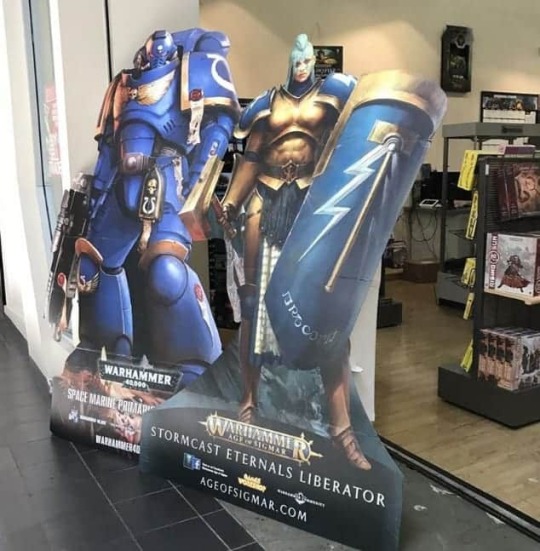
These are the power fantasies you’re encouraged to identify with. I think we all know how appealing this stuff can be to twelve year old boys, and, sure, that’s nothing new. When I was growing up all the kids were into GI Joe and Transformers, and the generation after me were very excited about the Power Rangers and there is absolutely a discussion to be had about selling kids media that tells them violence is a good way to solve problems. In many of those cases though, the message is that the violence is in defence of some quality like freedom, justice, the earth, etc. Space Marines are Facists, they’re involved in a constant expansionist war in service of an Imperium that’s theocratic, xenophobic, and doesn’t seem to have any concept of human rights.

Sure Bernard, let’s not talk down to children, but also, let’s recognise that they don’t always have the context to be critical of the media that’s being presented to them, particularly if that media is one-sided in its narrative. This is why I think we need to be concerned about how military simulators like Counterstrike can act as recruiting tools. In the case of 40K, it’s been a long time since the game and the media around it have made it explicit that the Imperium is a Fascist state. All that’s really presented is the power fantasy associated with the ‘human’ space marines, and the values that come along with it, so I don’t think it’s really surprising that we’ve ended up here:
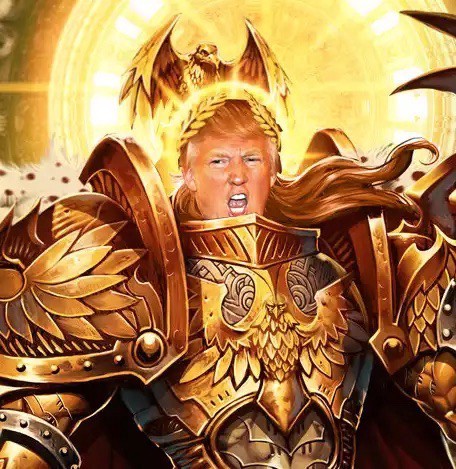
Trump doesn’t quite share the values of the Imperium of Man, he’s more isolationist than expansionist, and he’s more kleptocratic, while the Imperium is more Theocratic, however there are definitely similarities in how his followers see him, and how the Emperor is presented in 40K. They’re both seen as the heroic ideal of a charismatic strong-man, able to take a stand against ‘alien’ forces arrayed outside the state, and ‘degenerate’ forces inside, through a focus on militarism and national security. Again, the 14 characteristics of Fascism include a number of points where the politics of Donald Trump and the Imperium of Man intersect. I’m absolutely not saying that all kids who play 40K grow up to support Fascism, however it is likely that some people who were presented with the ideology of the Imperium as teenagers and weren’t equipped to critique it would have grown up to see something they could identify with in Trump’s politics.
It’s funny because if Trump did exist in 40K he’d be an ork, but the biggest ork already shares a name with Margaret Thatcher, and of course contemporary GW are too cowardly to name a space ork after Donald Trump.
Back to the point though. I think it’s really easy for kids to identify with Space Marines partly because they look really cool and heroic, but also in large part because they’re part of the human faction. We’re used to looking at humans as the good guys in Sci-Fi and Fantasy because it’s easy for them to act as audience inserts. There’s a common refrain in 40K spaces that ‘there are no good guys’ and I think this comes from an assumption that if humans aren’t the good guys then nobody else can be. The Eldar and Tau are definitely *less* messed up than the Imperium and I think what’s often overlooked is that their actions against humans are a response to Imperial expansionism. It seems like the Tau were originally intended as a foil to the Imperium; their value of the greater good was presented as a genuine positive, the Fire Warrior video game showed the Imperium as Fascistic and put you in the role of a Tau fighting their expansionism. These days, however, GW seem more focused on redeeming Space Marines (lol), and they’ve introduced all sorts of stuff about the Tau maintaining power through mind control (because of course nobody in their right mind would submit to Space Socialism). In any case, I think kids are less likely to associate with the Tau because they’re not human. I guess GW thought the anime aesthetics would appeal to a younger audience because kids like cartooons, right?
This is where I remembered there was an attempt a few years ago to put together some Warhammer media for kids. There’s still a website and a Youtube Channel but it doesn’t look like it went very far. Watching the Adeptus Mechanicus child inventing things with his cute Jokaero friend gave me whiplash. I’m confused that they’d make all the characters Imperials, but maybe they were giving it a bit before they showed an Eldar child setting out on their journey to become a ranger or a young Tau and their Kroot friend. Or maybe GW think only human characters are accessible to kids.
Anyway, if GW are going to be selling to a young audience (and I don’t think that toothpaste’s going back in the tube), then I think that at least for that audience they need to shift 40K’s focus a bit, it needs an outside perspective on the Imperium. One of the reasons the Imperium is so normalised is because they are the perspective faction. Most of the books, most of the video games and all of the TTRPGs are from the Imperium’s perspective. Players can’t see the Fascism for the Fascists. My suggestion would be to have the perspective characters be humans who aren’t Imperials, and who are engaged in resistance against the Imperium.
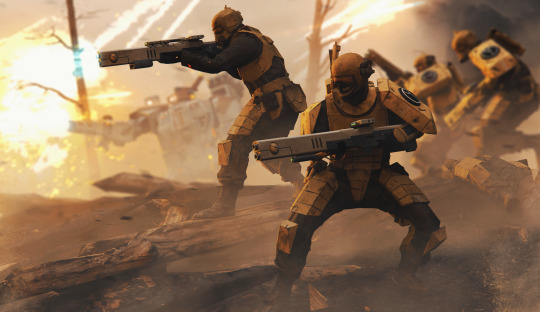
Gue’vesa by ComradeMatt on DeviantArt
They’re called Gue’vesa. Some time in the 2000s someone decided to release rules for using human auxillaries in Tau armies. It makes sense, the Tau Empire is unique in 40K in being multi-ethnic, and the Tau would much rather incorporate ex-Imperial worlds into their Empire than fight them. Having the Gue’vesa as perspective characters would work because it would put the Fascism of the Imperium into perspective. Gue’vesa characters would be aware of the tyranny that caused their planets to secede from the Imperium, as well as the threat of being reconquered, they know they’re all considered excommunicate traitoris. The Tau Empire is multi-ethnic, which is a foil to the Imperium’s xenophobia, Gue’vesa characters would likely work side-by-side with Tau, Kroot and others. The Gue’vesa can’t be Nationalistic because they’re part of a wider Empire. The wiki page describes these worlds as having freedom of religion. Also, the joke is that the Tau are Space Communists. If that’s the case then perhaps the Gue’vesa have actual trade unions. Imagine! Trade unions in the 41st Millenium! So yeah, Gue’vesa make good perspective characters because they’re humans, but they’re also involved in a Star Trek like alliance of worlds that’s a more optimistic view of the future and doesn’t bring the Imperium’s Fascist undertones.
There are some things I’d want to change about how these units are depicted though. The rules that were released just take an Imperial Guard unit and put it in a Tau army, with some Tau weapons. What this fails to recognise is that the way Imperial Guard squads work is a function of the Imperium. The Imperium just throws bodies at their problems, with little regards for human life. The Tau Empire is much more efficient, partly because they’re younger, but also because they’re smaller and can’t treat their troops with the same disregard the Imperium does. It’s likely that human troops serving the Tau Empire would be much better trained than their Imperial counterparts. Gue’vesa troops would likely be elite and highly specialised. They would have the advantage of Tau technology, but also, given Tau would have access to Imperial technology through the Gue’vesa, but without the superstiton of the Adeptus Mechanicus, there’s a possibility that Earth Caste scientists could reverse engineer Imperial technology and make improved versions of it available to Gue’vesa troops. With those kinds of advantages it makes sense for the Gue’vesa to serve not as auxilliary units but as an army in their own right.
So here’s what I’m picturing. The Gue’vesa army is made up of very small, highly trained and specialised, well equipped units. Commanders are accompanied by various T’au and human advisors. Units similar to Catachan veterans could be accompanied by Kroot trackers, while using drones and stealth battlesuit technology to keep themselves safe. They could even field something similar to a Space Marine in a melee role using battle-suit armour and power weapons. T’au likely have the technology to provide Gue’vesa with jetbikes or similar. This would all be accompanied by the standard battle suits and hover tanks.
Obviously all these units are completely mixed-gender. No more squads of dudes with a single femme head option.
(Here’s the bit where I might really upset the GrimnDark fans, but the absence of the Imperium from human worlds is likely to result in a lot of unsanctioned psykers, and there’s a possibility that Exodite Eldar seers might notice this, and grudgingly offer to train these psykers in the path of the seer so they’re equipped to resist the warp’s influence, because having daemons crawl out of their heads is a problem for everyone. So maybe they can field units of actually stable psykers)
Guard verteran units can look really cool, which is a shame because they’re likely to get annihilated just like other guard units. With a bit of extra stealth and drone technology though, (and perhaps pulse rifles) they could fill a role similar to Eldar Rangers. It’s the armoured, power weapon wielding melee units you want to make the cut-outs for the store though. They’d look badass like a Space Marine, but their fervour is about freedom from Imperialist oppression and standing side-by-side with their non-human allies. It’s still a violent power fantasy, and that’s not great, but it’s one with better values behind it and it at least makes a space for a conversation about the Imperium’s Fascism.
Anyway, that’s what I’d do if I were Games Workshop and wanted to keep selling toys to kids, but also wanted to address the shift towards Fascism in some fans. Obviously this is a long-term project but it doesn’t seem like 40K’s going away any time soon.
25 notes
·
View notes
Text
Decadence, Degeneration & the Drukhari

I think the Eldar are really interesting. While other Xenos in 40K, like Orks and Tyranids, represent a sort of general external threat, Eldar bring some other ideas along with them. I’m afraid we’re going to have to talk about Fascism again, but there’s some other fun stuff too.
So Eldar represent two things that Fascists don’t like (see my previous post if you want evidence that the Imperium is a Fascist state). The first is intellectualism. Fascism demands an uncritical adherence to national myths, and intellectual movements tend to question things like that, so Fascists are by necessity suspicious of intellectual “elites”. Eldar are depicted as more psychic and more cultured than humans of the Imperium, and they’ve been around longer, so they have greater knowledge of things. It’s the Eldar who maintain the big repository of information about the galaxy, in the form of the Black Library. (Maybe someday we can look at the weird relationship the Inquisition has with the Eldar, and how that organisation seems to simultaneously seek out knowledge and supress knowledge) The second thing is that Eldar, shall we say, fail to live up to the Imperium’s heteronormative models of gender. The Imperium, like all Fascist states, venerates hyper-masculinity, I’m not sure I need to argue this one when I can just point at a Space Marine. The Eldar, by contrast, are represented as somewhat efette; elegant and graceful, but physically weak. Orks used to refer to Eldar as “pansies”, GW seem to have realised that maybe getting rid of that bit is a good idea in the 21st Century and so it seems to have been retired. The fact remains, though, that Eldar’s relationship with gender is a bit queer. From the start Eldar have been depicted as androgynous, they’re slight of build, wear form-fitting clothes and tend to wear their hair long. In 1998 GW first released Dark Eldar, which complicated things. Dark Eldar are kinky, but they’re also much less androgynous than Craftworld Eldar or Harlequins. Wyches in particular are really interesting. They’re the first genuinely mixed-gender unit I remember GW releasing, (there were also some Craftworld and Dark Eldar plastic kits around the same time that included a single chest piece with boobs) the miniatures were explicitly gendered, and they were really kinky, there was a lot of skin, a lot of spikes, and a lot of whips. Basically Craftworld Eldar are sort of gender neutral and Dark Eldar are chaotically genderqueer. All of this is the kind of thing that Fascists hate. Fascism centers the role of the heteronormative family unit, which has the role of making more “racially pure” babies (the Nazis called in the Lebensborn program), queer people who reject the gender roles that that unit relies on are therefore instantly suspicious to Fascists. So, to the Imperium, the threat of the Eldar is not just that they’re Xenos, they also present an ideological threat. The Eldar’s intellectualism and knowledge about the galaxy is a threat to the Imperium’s narrative and myths about itself and the universe it’s up against. Their queerness is a threat to the heteronormative gender roles that the Imperium is structured on.
At this point maybe some people are thinking “but aliens and daemons and cults and unsanctioned psykers are a real threat and the Imperium does need to keep throwing bodies into wars to stop them.” The thing is, Warhammer 40,000 is a fantasy about what would happen if all those threats really did exist out there, it’s the aesthetics and ideas that are important. In the real world Fascism is never justifiable, its arguments are never coherent, it only makes sense in 40K because 40K is fantasy.
So, decadence and degeneration, the things I put in the title. If you’ve ever been called a degenerate by some keyboard Fascist, just know that you’re being interpolated into a long tradition. Around the Fin de Siecle (the end of the 19th and start of the 20th centuries) there were some ideas about decadence and degeneration doing the rounds in Europe. Now I’m probably going to mess this up a bit, but the theme is that due to the rationality of Men, civilisation generally advances on an upward trajectory. I assume this idea came out of the enlightenment, reason leads to progress and makes society better (obviously there are some Colonialist ideas that come out of there). Maybe it’s useful to call this process generation (idk, I’m really winging it here), but anyway, these men are distractable, and if they allow themselves to be distracted by aesthetic things, like the colour yellow, or the taste of absinthe, or the feel of high quality brocades, or the skin of other men, they might become... decadent. Decadence is supposed to be when you give up rationality and hard work to focus on a life of sensation. Obviously there’s an implication here about sexuality. Oscar Wilde was regarded as a decadent. Too much decadence, it was thought, could lead to the reversal of a civilisation’s progress, degeneration, in other words. Versions of this idea pop up all over the place, certain Conservatives regard Western Civilisation as having fallen from the ideal state embodied by the Ancient Greeks (and I don’t doubt these people would blame decadence), and it’s also really common in fantasy. In the Lord of the Rings, the state of the world has fallen from the Númenorean and Elvish civilisations of the distant past, and Elric of Melniboné describes a previous civilisation brought low by decadence.
But, Eldar. So the story of the Eldar is they had this big galaxy-spanning civilisation before humanity reached the stars. As their civilisation became more advanced and the automation of their physical needs freed up their time they started to become decadent, and as they pursued various pleasures and became more and more jaded, the decadence gave way to sadism.
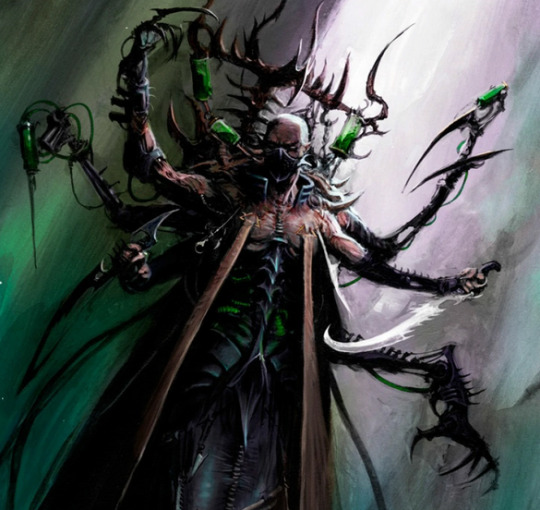
The descriptions of the dying days of the Eldar civilisation sound like being at the worst kink club you’ve ever seen, where nobody’s heard of consent and everyone’s really into knives and medical role-play. Various groups of Eldar began to leave their empire. First the Exodites, who went to live a sort of monastic existence riding dinosaurs about on idyllic worlds as far away from the Eldar empire as possible (it’s a travesy that GW have never made models of them because they’re the coolest thing in 40K).

Then the Craftworld Eldar fled. All the bad and horny psychic energy released by this debauchery built up in the warp (because Eldar are very psychic) and gave birth to Slaanesh, the Chaos god of excess and decadence, exploding all the heads of the decadent Eldar and ending their civilisation. Those Eldar left are supposed to be fallen from civilisation. There’s a sense that they’ll never be able to regain their old empire and their only role now is to become extinct with as much dignity as they can.
The fall of the Eldar is exactly the kind of thing that the Imperium would use as a cautionary tale to frighten its citizens. “Get too curious, or too decadent, or fail to uphold the family model, and your civilisation might collapse.” I wonder sometimes if the whole story was originally just meant to be Imperial propaganda, but these days the game certainly treats it as real. Now, I’m not sure there’s a heap of evidence to suggest that 20th Century Fascists were particularly interested in the concept of degeneracy (although the Nazis thought it relevant as regards art). 21st Century Fascists seem to love the concept. I think it’s fair to say that ideas of degeneration formed part of the cultural millieu of the early 20th Century that fed into Fascism. In any case the ideas that some cultures are more civilised than others, and that decadence can cause a culture to fall into a less civilised state, are consistent with Fascism.
So, again, we’re talking about a piece of fantasy media here. Saying “the Eldar were decadent and degenerate” or “the Imperium’s rejection of the Eldar’s degeneracy makes sense because they did give birth to Slaanesh” is meaningless. The Eldar are a piece of media that express an idea, they play with the concepts of degeneracy and and decadence to tell a story.
23 notes
·
View notes
Text
Space Marines are not your friend
... and the Imperium of Man are not the good guys.

These guys, with the iron crosses and the scary face-masks, surprisingly not very nice.
So, there’s this idea that came up a bit in the discussions around space marines and gender that sometimes these guys can be heroic, and, um, actually it’s how they’re perceived as heroic that’s kind of the point, but we’ll come back to that.
Milton Bradley and Games workshop teamed up to release Space Crusade when I was 6 or 7 and I pestered my parents until they bought it for me for Christmas. Later, when I was 11 I was stuck at home with glandular fever and my family picked up some White Dwarf magazines from the local library for me to read and I realised there was more going on with this world, and I thought space marines were pretty cool. I used to imagine being a space marine. That’s because I didn’t understand what they represented. As I got older, and started to learn more about the symbols that GW were drawing on, that idea became less and less appealing.
In Warhammer 40,000, the Imperium of Man is a Fascist state. To be very clear, I don’t think it’s a bad game or fascist piece of media for depicting this. I think it was the intention of the game’s original creators to critically depict a futuristic dystopia, and the Fascist setting is part of that.
I think it’s clear that the Imperium engenders several of the 14 characteristics of Fascism identified by Lawrence Britt pretty unambiguously. The first is powerful and continuing Nationalism, Nationalism is based on the idea that a state should be congruent with a particular people, or volk, and outsiders should be excluded. Nationalism in the 41st Milennium is different to the Nationalism we’re used to because the volk in question is all of humanity, and the excluded parties are what the Imperium calls Xenos; Eldar, Orks, Tau, etc. Then there’s disdain for the recognition of human rights, human rights don’t really exist as a concept in 40K. You might ask the servitor or arco-flagellant about their human rights, or the 10 year-old child who’s taken from their home to begin the process of becoming a space marine. Identification of enemies/scapegoats as a unifying cause is a big one. The vilifcation of heretics, mutants and xenos is kind of a central tenet of the Imperium’s culture. There’s supremacy of the military, uh, I’m not sure I need to explain how the Imperium glorifies the Imperial Guard, the Astartes, all the chambers miltant, the knightly houses, the titan legions, the imperial navy, etc. etc. Rampant sexism, I hope my previous post has demonstrated this, but I think it’s important to note that sexism isn’t just disliking a particular gender, it’s expressed in the reinforcement of traditional and hegemonic gender roles, as I think the comparison of the Astartes’ and Sororitas’ roles demonstrates. There’s an obsession with national security, the Imperium’s entire economy is geared towards expansionism and dealing with internal and external threats. The intertwining of religion and government is pretty clear, the head of state is seen as a god and his church is the beaurecracy that runs the Imperial state. Supression of labour power is kind of assumed, there are no unions in the Imperium. The disdain for intellectuals and the arts is demonstrated by statements like “an open mind is like a fortress with its gates unbarred and unguarded” (That’s from Dawn of War). And there’s an obsession with crime and punishment, embodied by the existence of the Inquisition, in particular the Ordo Hereticus, who are a police force with unlimited power and the capacity to dragoon military units into their service.
These points often meet with the objection that the internal and external threats *do* exist and that therefor the Imperium’s response to them is justified, which kind of misses the point that this is a piece of fiction, an exploration of ideas. The existence of Xenos and the Chaos Gods doesn’t make the Imperium’s response to those things any less Fascistic, and they definitely don’t justify the existence of Fascism in the real world.
But, Warhammer 40,000 is an aesthetic game and Fascists looooove aesthetics, so I think an examination of how the Imperium draws on the aesthetics of Fascism is a bit more interesting.
Here’s a Susan Sontag quote I copied from the Wikipedia page on Fascism: “[f]ascist aesthetics ... flow from (and justify) a preoccupation with situations of control, submissive behavior, extravagant effort, and the endurance of pain; they endorse two seemingly opposite states, egomania and servitude. The relations of domination and enslavement take the form of a characteristic pageantry: the massing of groups of people; the turning of people into things; the multiplication or replication of things; and the grouping of people/things around an all-powerful, hypnotic leader-figure or force. The fascist dramaturgy centers on the orgiastic transactions between mighty forces and their puppets, uniformly garbed and shown in ever swelling numbers. Its choreography alternates between ceaseless motion and a congealed, static, 'virile' posing. Fascist art glorifies surrender, it exalts mindlessness, it glamorizes death."
I’m not going to provide a reference for that because this isn’t an essay and you’re not my lecturer and someone already did all the work (it’s in the wiki, linked above). I think I’m just going to take some extracts from that and juxtapose them with 40K art. Here goes:
a preoccupation with situations of ... extravagant effort
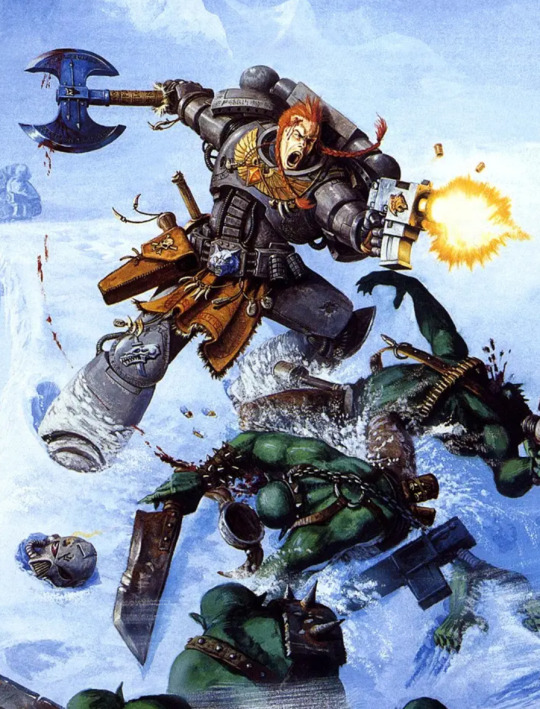
and the endurance of pain

they endorse two seemingly opposite states, egomania and servitude

a characteristic pageantry: the massing of groups of people
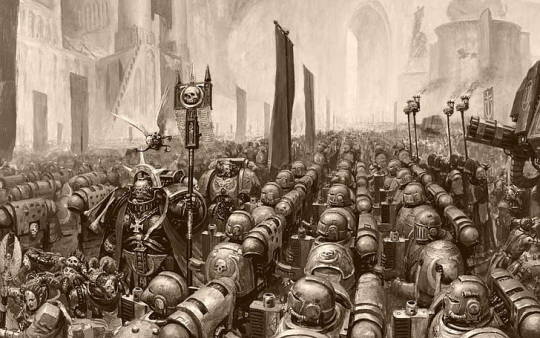
the turning of people into things
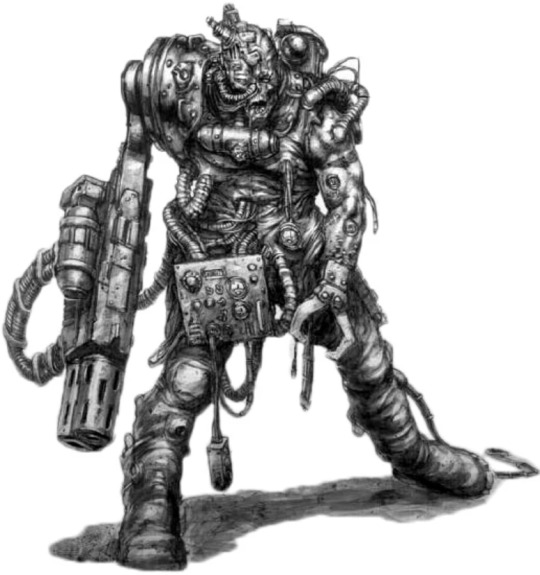
an all-powerful, hypnotic leader-figure or force
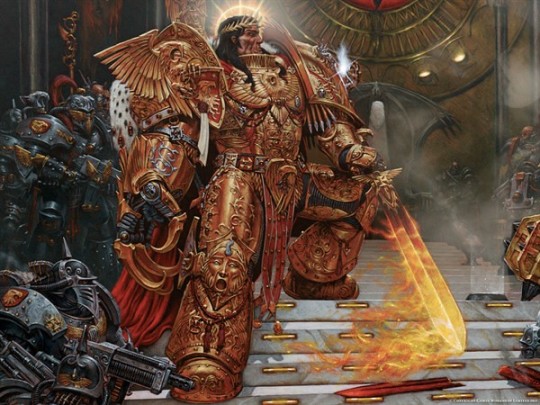
The fascist dramaturgy centers on the orgiastic transactions between mighty forces and their puppets, uniformly garbed and shown in ever swelling numbers
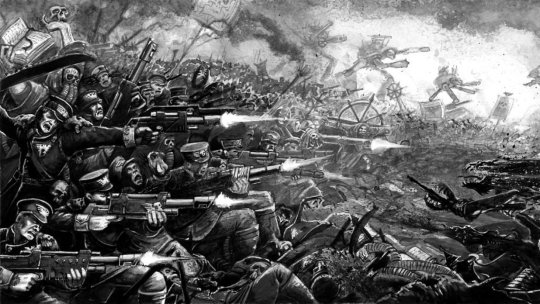
a congealed, static, 'virile' posing
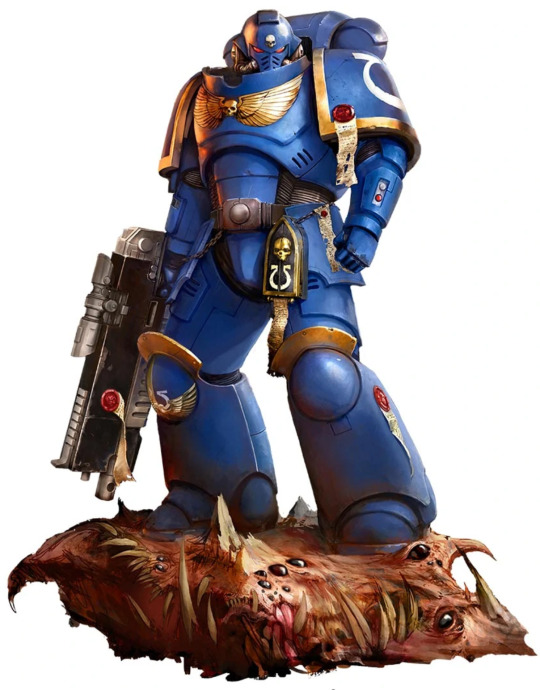
it glamorizes death

(I thought about adding a little speech bubble saying “even in death I still serve” but I think most people reading this recognise that that’s a walking, fighting coffin, I don’t think there’s a more explicit depiction of the glamourisation of death than the idea of a warrior so commited to war they they allow their corpse to be interred in a fighting machine so they can continue to kill after they’ve died.)
I’m particularly interested in how space marines fill the role of the ‘hero’. Nazis loved art that showed idealised male figures, preferably from pagan myths. Here’s a sculpture of Prometheus that was exhibited at their “Great German Art Exhibition”:

They loved heroic figures, muscular and mythic men of action. They saw in Nietszche’s ubermensch an individual who had the strength and will to do what he wanted, and take what he wanted, without concern for the morality of the ‘sheep’. It goes without saying that these figures were meant to be of Aryan descent and in the Nazi state the SS were meant to be the modern expression of this. Recruits to the SS had to ‘prove’ their Aryan ancestry and Himmler had plans to institute requirements for appearance and height. I think it’s clear how they were meant to be a fighting force who’s superiority came from their supposed genetic superiority and connection to an idealised Aryan heroism.
And that’s where space marines come in. Astartes are the way they are because of their connection, through gene-seed, to the primarchs (The Emperor’s largest sons), heroic and promethean figures from the dawn of the Imperium who made war on a grand scale and spread the Emperor’s light to the far reaches of the galaxy. Their genetics make them into literal superhumans, able to perform heroic feats that would be impossible for a regular person. This isn’t a good thing, it’s an expression of Fascist ideology. Warhammer 40K, being satire, recognises this, and so it’s constantly made clear that these people are incapable of anything but war. Also the marinification process makes them so muscular they resemble sides of beef more than actual people, they’ve become a grotesque mockery of the ideal of the Hero.
Also there are skulls and eagles on, like, everything, and that’s normally a sign that Fascists are about. There’s also a particular fascination Fascists have with the imagery of the Roman Empire, the word Fascism comes from fasces, a bunch of rods bound together with an axe that was the symbol of Roman dicators. Ultramarines in particular use a lot of Roman inspired armour elements.
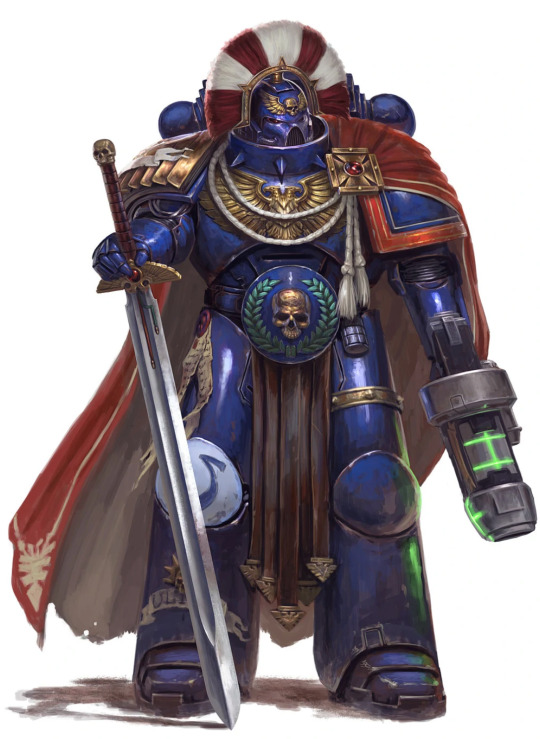
The headpiece, wreath at the midriff, and leather straps hanging between the legs are all screaming Rome at me, and I don’t think these guys are history buffs (They’re Fascists).
Anyway, there we go, I think I’ve established that the original 40K writers intended for the Imperium to be a Fascist state. I’m enjoying this, maybe next I’ll write something about the Eldar and Slaanesh and ideas aboout degeneracy that were floating around at the turn of the 19th Century.
UPDATE: I've developed my thoughts on this further here.
169 notes
·
View notes
Text
Gender and Warhammer 40,000
Look I’m sorry. It’s been a long time since I’ve played 40K but I still find the setting really interesting and also I have *opinions* (also I’m thinking it could be fun to play some Dark Heresy).
Dudes who play 40K love to point out that there can’t be any space marine women (they say female space marines) because of how you can only have like eight livers and two hearts if you’ve got XY chromosomes or something. Anyway it’s really difficult reading about this stuff because every post about it has this energy.

So why aren’t there space marine women? There were, back in 1st edition, this post from Bell of Lost Souls includes two models that were released of space marine women and talks about how retailers asked GW to stop sending them because they couldn’t sell them to their players, who in the 80′s were mostly men. As far as I can tell the stuff about only men being able to survive the space marine making process because of some chromosome rubbish was just post-facto justification for discontinuing those models.
Which is a shame because there’s a better justification. Someone on Twitter was pointing out that they’re basically children kidnapped by the Fascist empire and turned into supersoldiers. Of course the Catholic Fascist space Empire isn’t making space marine women. I think it’s pretty clear that the space marines were initially intended as a pastiche of Thatcherite militarism, just like Judge Dredd. In the Rogue Trader they’re depicted as thuggish, inhuman instruments of the state.

I also feel like there’s something about English boys’ public schools going on here. I’m not from the UK so I’m not sure I can quite make sense of it but there was a decision made to have the punk hive-ganger’s butt be really prominent in the image.
There aren’t women space marines for the same reason there weren’t women in the Sturmabteilung. Military organisations in Fascist states serve a double purpose, they don’t just fight, they also serve as propaganda. It’s clear from most 40K imagery and fiction that the image of the space marine is meant to communicate the strength of the Imperium. Imperial propaganda calls the Imperial Guard “the anvil” and the Adeptus Astartes “the hammer” in an empire that seems fixated on hammers, in a game that is largely about hammers (it’s called Warhammer).
But here’s the interesting bit, the image of the space marine *also* communicates the Imperium’s ideas about the role of men. The figure of the space marine represents the glorification of toxic masculinity, not just because it depicts men as warriors and protectors who are inherently violent, but also because these are men who are utterly disposable and who’s subjectivity and individualism have been completely erased for the sole purpose of making war. The primary role of a space marine apothecary isn’t to heal wounded marines, it’s to ensure that their gene-seed is harvested at the point of death so they can make more marines. It doesn’t matter that space marines die, only that hyper-masculine bodies can continue to make war.
I can imagine some Imperial Guard recruitment poster with a picture of a space marine saying “They put their bodies on the line to protect the Imperium, and you should too! Join the Imperial Guard!”
But, if we’re going to talk about what ideas the Imperium wants to engender about women, we need to talk about everyone’s favourite nuns with guns.
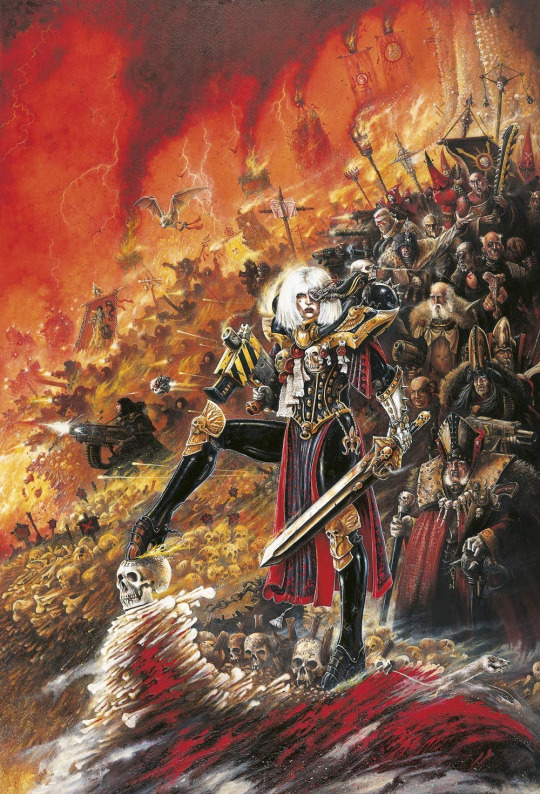
Okay that image probably doesn’t communicate what I’m trying to say but I had to include it, here’s Saint Celestine.

So the Adepta Sororitas, actualy first here’s a Reddit post with an extract from a Rogue Trader scenario including a chapter of space marine women called The Little Sisters of Purification (you know they’re carrying a lot of flamers). This is interesting because while Astartes are technically supposed to be monastic, their imagery (with the exception of the Dark Angels, and in that case the major theme is HERESY) rarely leans on that aspect. From the start, the Imperium’s women warriors have been explicitly coded as nuns.
The themes that come through with the sisters of battle are things like purity, innocence, piety, faith, martyrdom. They have a propaganda role, like the space marines do, but it’s a different message. While the Astartes’ singular military role communicates the idea that men are only good for violence, the Sororitas fill a bunch of different roles, the order hospitaller provides medical aid to Imperial citizens, the order dialogous are diplomats, and the order famulous are scholars. This communicates that the role of women in Imperial society is more diverse, and less dispensable, an idea that’s probably reinforced by the various orders’ integration into Imperial society. Sisters would be a much more familiar sight to Imperial citizens than marines, who are largely aloof on their fortress-monasteries. It’s likely that most Imperial citizens would be much more shocked by the idea of the nurse-nun they go to see every few months being killed than some armoured super-human with no personality other than anger who they’ve never met.
And that’s where the idea of martyrdom comes in. Toxic masculinity says that women must be protected, by men, because they’re not dispensable in the way men are. The Emperor, in all his masculine wisdom, will not countenance women to be killed in his grimdark future of only war, so Sisters of Battle aren’t killed, they’re martyred, and often when they are He brings them back in the form of living saints (See Saint Celestine, above). There are no resurrected space marines because the Imperium treats men’s bodies as expendable, and women’s bodies as sacred.
And then there’s the whole purity and innocence thing. Sosoritas are obedient to the one man in their life (Him on the Golden Throne). They take vows of chastity, they spend most of their time in prayer, they’re probably the faction in the game with the most number of abilities based around faith, piety and purity (I didn’t count or anything, but I think it’s a safe assumption). They play a propaganda role to demonstrate to Imperial citizens what a woman should be like, and also how men should enlist to protect them.
So when I see people modding their space marine armies to include women space marines I end up in two minds. On the one hand it makes me happy because it’s clear that it’s going to upset guys who are invested in the idea that women are inherently weak, but at the same time I worry that they’ve missed the bit where this is a sexist Fascist Empire and maybe they’re thinking the space marines are the good guys.
On the other hand, often when this topic comes up, people mention that the records of two of the 20 primarchs are expunged from all records. I kind of like the idea that while the Imperium still keeps records of the traitor primarchs, it’s the idea that there were two women primarchs that’s so horrific to the Imperium’s scribes that they had to destroy all records of them.
186 notes
·
View notes
Text
Hexblades!

Image credit: Elric of Melniboné by Robert Gould
I used to hear about this build where you’d take a warlock with two levels in paladin so you could use warlock spell slots for divine smites. Apparently the game designers heard about it too because they created the hexblade, which is basically a warlock that gets smites and the proficiencies needed to be in melee. A few years ago I was reading Elric of Melniboné stories by Michael Moorcock and I suspect the designers borrowed a looooooot of inspiration from Elric when they made the hexblade. Go read them, they’ve got that early to mid-20th century sword and sorcery pulp feel with all the weirdness and darkness that often entails.
I love warlocks in general, the patron’s presence in a campaign has so much potential to drive roleplaying and storytelling, but that can be even cooler when the presence is embodied in the actual weapon you’re using.
So how do you run them, and how might you tank with them? For starters, your important attributes are dexterity, constitution and charisma. Charisma is obviously important for all warlocks, constitution will give you more hit points, which you’ll need because you’ll be in melee a lot, and dexterity is important because it boosts the AC of the medium armour you’ll be wearing. If you’re planning to tank, you might even consider making your dexterity 16 to start with and going for the medium armour master feat so you can really soak up hits (with scale mail and a shield that’s an armour class of 19). If that means your dexterity starts higher than your charisma you could take a finesse weapon to start with. Charisma will become important for spells but it can probably wait. This might be a situation where you want to buy your starting equipment because the standard warlock starting equipment isn’t really geared towards this sub-class, however the average gold warlocks have to spend is 100gp and a chain shirt or scale mail, along with a rapier, shield, and cheap arcane focus already costs 95gp so be careful.If you want to take advantage of that high dexterity, urchin is a useful background since the warlock class doesn’t give you access to any dexterity skills.
This subclass was clearly designed to work with the pact of the blade boon (no pact of the chain means no quasit and that makes me sad). This boon doesn’t give you a great deal to start with but it does give you access to eldritch invocations with a particularly martial focus. Improved pact weapon allows you to use your weapon as an arcane focus and gives it a +1 bonus if it doesn’t already have it, this can be really useful at lower levels before you find a +1 weapon, and then you can swap it out for a different invocation. At fifth level you get access to thirsting blade, which allows you to attack twice, and eldritch smite, which works similarly to a paladin’s smite, these are must haves. Finally at twelfth level, lifedrinker allows you to do extra necrotic damage equal to your charisma modifier when you hit. Other invocations that might be helpful are fiendish vigour; the temporary hit points from false life will help keep you alive, cloak of flies, which will do poison damage to nearby enemies, and undying servitude; having a skeleton or zombie by your side that you don’t need to concentrate on will help keep you in the fight longer.
Concentration is something to consider though. You’ll have access to some useful concentration spells like hex, several smites, eldritch weapon, spirit shroud and blade of disaster that have ongoing benefits (shadow blade might seem really good for hexblades but it’s not a pact weapon so it doesn’t work with your invocations). Warlocks aren’t great at concentration saves though, and you’re going to be getting hit a lot. If you want to use these spells then you might want to take the tough feat to give you proficiency in constitution saves (and +1 con) as well as the eldritch mind invocation to give you advantage on concentration saves.
Really they’re a lot like paladins that feel slightly... wrong. There’s a sense in the Elric stories that he’s been physically weakened by the weapon he uses, and his martial prowess is maintained by his force of will and the weapon driving him. I think the way this subclass combines the use of charisma for attack and damage rolls with a slew of curses and necromantic spells really helps communicate that feeling. I haven’t touched on the hexblade’s curse or accursed spectre features because they’re pretty straightforward but they certainly help create that tone.
10 notes
·
View notes
Text
The unconventional tank
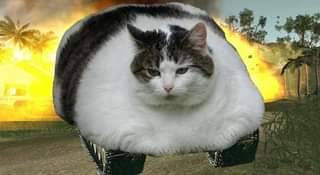
Mostly when people think of tanking they think about armour, heavy armour, plate if possible, with a shield and something sharp or blunt to hit things with. It makes sense; the tanks with tracks and guns are covered in metal, and it’s a method that works; Heavy armour with a shield and one-handed weapon is a great way to avoid damage. Starting out with chainmail and a shield gives you an armour class of 18 on its own, which can increase to 19 with the defense fighting style. Full plate can increase this to number to 21 once you can find or afford it.
The problem with tanks, of course, is that they make a lot of noise. Every player I've known who's run a fighter or paladin has lamented their terrible stealth checks when the rest of the party starts sneaking around and all their bits of metal start clattering together. It doesn't have to be this way though. A character, in particular a fighter, paladin or ranger, can very easily approach or match the armour classes heavy armour allows by wearing medium armour and focusing on dexterity. If you want to run a character who feels more elegant while tanking, you could try this.
The method involves taking dexterity instead of strength as a character's highest attribute, it should be possible to get a 16 or 17 using the standard array. Finesse weapons are, of course, very important for this build. A rapier and shield is just as effective as any of the other one handed weapons used this way, such as longswords, morningstars or flails. Starting with a chain shirt, along with a shield and the dexterity bonus gives an armour class of 17 (or 18 with scale mail, but that can be noisy). The defense fighting style raises this number again. The key is the medium armour master feat, it extends the dexterity bonus for medium armour to a maximum of +3 and allows the wearer to ignore the stealth disadvantage imposed by scale mail and half plate. It can be taken at level four (or level one with a variant human). With a dexterity of 16, half plate, a shield, the defense fighting style and the medium armour master feat, one of the martial classes can reach an armour class of 21, the same as full plate and shield, for half the cost, and with the ability to sneak around with the others. The defensive duelist feat could also be quite fun here, it allows you to add your proficiency to your armour class as a reaction, it’s nice little buff and gives the sense of a skilled swashbuckler.

While fighters, paladins, rangers and of course barbarians make the most effective tanks, most classes include a sub-class that allows for something like tanking, for the record, I haven’t tried most of these, so if you have I’d love to hear how it went. Each of these options have a D8 for their hit die, making them less survivable than the martial classes, so a high constitution is very important if you want to tank with them. Those on this list who use medium armour can also benefit from the medium armour master feat. Arcanists have the armourer, giving them access to heavy armour and shields, and improving their armour overall. Bards have the college of valour, giving them medium armour and shield proficiency. Clerics have several very tough options, as I looked at in my series on them. Druids have access to the circle of the moon, giving them very tough wild shape options. Instead of putting on a lot of armour, just turn into a bear! Monks can be a bit more challenging, as they don’t get armour proficiency and their armour class is based on a combination of Wisdom and Dexterity. With the standard array of attributes they might start with an armour class of 15 or 16, but this will advance very slowly as they level, and they can only reach a maximum of 20. Tanking with a rogue would be challenging too, but you could give one the moderately armoured and medium armour master feats, this would fit thematically quite well with the swashbuckler subclass. Probably don’t try to tank with a sorcerer, they have D6 for their hit die and no armour proficiency, it’s going to end badly. I’ll do separate posts on the hexblade warlock and bladesinger wizard because they’re both quite complicated and deserve the time. Also I need to figure out how that wizard works.
3 notes
·
View notes
Text
What do you mean when you say roleplaying?
So I see this discussion come up every few weeks.

And, like, I agree in general that D&D has problems with *some kinds* of roleplaying, but also I think that actually there are different ways to roleplay, and some of those are served better or worse by different rules systems.
So the problem is character interactions. D&D handles interpersonal stuff between player characters and non-player characters badly, and it handles stuff between two player characters worse. There’s an often unspoken assumption with these kinds of interactions that players will play out what what their characters say to persuade or intimidate another character, it’s enjoyable and contributes to the storytelling (some players prefer not to and that’s fine). The DM will then follow this up by asking for some sort of check, almost always based on charisma. There are two big problems here, one being that success is entirely down to the roll and not what the player said, the other being that it’s almost always the bards, paladins, sorcerers and warlocks doing this because these checks so often rely on charisma. There are a few ways to improve the situation, some DMs might give advantage on a check for a particularly persuasive oration, or they might allow a character to roll persuasion with intelligence for a particularly rational argument, or with wisdom for an empathic one (the rules state that attributes associated with skills are only suggestions, so DMs should do this more), but there’s still a big gap between what a player says and whether they succeed. The other problem is that when a player decides they’re going to roll to intimidate or persuade another player, it can take away that player’s agency. This is enough of a problem that most DMs don’t allow social checks between players, but without a replacement, that leaves games with no system for handling interactions between players.
So, what are the other options? I’m going to talk about Powered by the Apocalypse games because Monster Hearts is on the embarrassingly short list of non-D&D games I’ve played. These are games designed with character interactions at their hearts, unlike D&D, which has combat at its heart. Stats are generally 4 or 5 things along the lines of hot, cold, dark, weird, volatile, aggro, things like that, and different social checks rely on different stats, so that different characters will be better at different types of social interactions. On top of this the checks these games call for are less about succeeding in persuading someone of something, and more about instilling a feeling in another character, you can roll to turn someone on or shut someone down, that player can then decide how they react to that, which helps to retain everyone’s agency. And then there are strings, these represent some piece of information or emotional connection that one character has on another. There are a lot of interactions that allow a character to get them, and a lot of ways to use them, but I think the most interesting way is when you want another player to do something. You can spend a string on them, and ask them to do the thing, if they do it, they get an experience point, pushing them closer to leveling up. I love it, it drives interaction between characters while maintaining everyone’s agency and rewarding cooperation.
So yeah, if you want to support character interactions there are definitely better games out there than D&D. (Also a lot of Powered by the Apocalypse games are very queer, so, like, play them)
What about different kinds of storytelling though? Sometimes you want to tell a story about a character who’s a badass, like Ripley, or Sarah Connor, or most of the people in The Lord of the Rings, or the Valkyrie in Thor: Ragnarok. Character interaction isn’t so important to telling these characters’ stories, what’s important is letting them perform awesome physical (or magical) feats, and that’s something D&D does really well. I made a post a little while ago on how you can use D&D’s mechanics to tell a character’s story. D&D’s rules are pretty complicated and there’s a library of abilities that are available to characters, this can be used for combat optimisation but it can also be used to express really specific elements of how a character is a badass in a way that’s not really available in smaller RPGs like Monster Hearts. Dungeon World looks really fun, but I think I’d struggle to make Yngvild Windrivver as intense in that system as she can be in D&D.
Anyway, it’s sort of an aside, but other people have talked about how there’s a false dichotomy between optimising and roleplaying, they call it the Stormwind fallacy. The idea is that it is possible for a character to be interesting, worth role playing, and also good at what they do. Nobody ever said “ah, Tolkein really nerfed Aragorn by making him a good character”. Roleplaying games aren’t wargames, the role of the game master is not to beat you, they create the world in which to tell a story, and in D&D they provide interesting challenges. You shouldn’t be in a situation where you need to optimise to survive unless everyone has agreed to play that kind of game, so the concept of nerfing is kind of meaningless here, very few people build their D&D characters to do the most possible combat damage, or healing, they build their characters based on what they like, or what tells their story, and they still successfully complete campaigns and have fun doing it.
Anyway, I think people should try roleplaying systems that aren’t D&D. I love D&D but I think it’s a terrible introduction to roleplaying games because it’s so complex and it focuses on combat at the expense of pretty much all other interactions. Playing other games can help you see which games are best for telling the story you want to tell, but they can also help you see what D&D does well. There’s no game that does everything perfectly, so play lots and see which ones work for you.
#ttrpg#dnd#DnD stuff#Dungeons and Dragons#role playing games#powered by the apocalypse#monster hearts
16 notes
·
View notes
Text
Role playing religious characters
I guess while I’m writing about clerics is as good a time as any to talk about this. Religion is a fundamental part of Dungeons & Dragons. The gods are active in the world and several classes’ powers are derived directly from divine entities. It may be different with other groups but I’ve often found that players struggle to express the religion of characters who are religious.
I have two thoughts about why this might be. The first reason is that D&D is power fantasy, characters feel really badass and I think this can drive a tendency in players to want to feel powerful. Recognising that your character’s power is derived from another entity can make that difficult, particularly when for most characters, power is an expression of martial training or academic study (or just being born with it in the case of sorcerers). It can take a bit of a shift in perspective to play a character whose power derives from their faith in something bigger than them.
The second reason is atheism. Not only that many more people grow up outside of religion than in the 70s when D&D was first developed, so there are fewer people who are familiar with it, but also that there’s a sort of general discomfort around the idea of religion which I think can make many people reluctant to engage with the idea of it. It might be that people see religion as too earnest for a game about bashing up monsters or that they see the major monotheistic religions of the real world as too corrupt and they don’t want anything to do with religion because of that.
Either way I think it’s worth exploring characters’ religion because it can lead to more compelling stories. Characters have lots of motivations but I think duty is a really interesting one. It can achieve several things to have a character with a sense of duty. The first is to easily give your character a set of motivations that aren’t necessarily your own, which is really important for role playing. Another is that having a connection to a deity or an institution like a church or temple ties your character into the world, DMs generally love this sort of thing because it gives them hooks they can use to engage your character and the party. Also, these kinds of motivations can help to get away from the good/evil understanding of characters (I think alignment is the worst thing about D&D), I find thinking about what a character will sacrifice their own needs, or betray others, for is much more compelling. Of course this commitment could also be to an ideology or an institution, religion is just one way of thinking about it.
In the 21st century, in the West, our experience of religion tends to be of monotheistic ones, whereas all the D&D settings (that I’ve encountered) are polytheistic. The domains system kind of makes polytheism inherrent to D&D (I guess you could make a monotheistic setting where domains reflect different aspects of a single god, but I haven’t seen that done). Polytheistic and monotheistic religions have very different characteristics and it often seems like people assume the qualities of monotheistic deities in polytheistic ones because of what they’re used to seeing, things like omnipotence, a claim to absolute morality and absolute authority. By contrast, polytheistic religions tend to depict their gods as much more human, they bicker, they’re jealous, their power is limited (a lot of the gods in D&D were once human).
If you want inspiration for how to play a religious character in D&D, don’t look at Christianity, look at heroic myths from polytheistic societies. Myths about gods are useful, but myths about humans are better because they tend to depict how those humans engage with the gods. The Iliad is particularly useful, with Achilles offending Apollo by sacking his temple, or Agamemnon’s sacrifices to Zeus in memory of the fallen Achaeans. It’s been a while since I’ve read about Cuchulain or Brynhilde or Gilgamesh so maybe it’s time to do some more reading. Having a character who worships a god or pantheon, but is also aware that there are other gods, and theirs is not all powerful, can be really interesting, it means your character’s acts reflect more on their god and maybe their god’s relationship to other gods.
I also think it’s good to practice role playing calling on your character’s god (or maybe the nature spirits in the case of druids and rangers) to lend you their power. Trust me, it still feels pretty badass to be role playing someone who’s channeling the power of divine entities.
5 notes
·
View notes
Text
The twilight domain
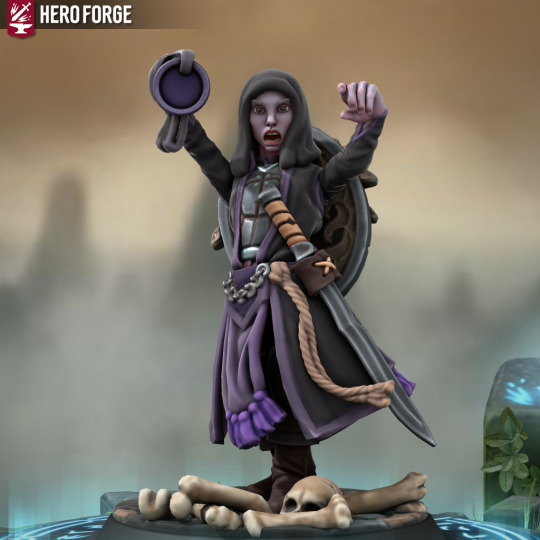
I’ve saved the best for last.
So initially I dismissed any associations between the twilight domain and a certain book and movie series about the undead, but now I’m not so sure. The main ability this domain has (apart from the 300 foot darkvision and the flying) is a 30 foot aura of dim light that allows you to give things in it temporary hit points, and later, cover. It also grants some aura spells which are normally only available to paladins. Anything involving an aura benefits summoners because the more creatures are in the aura, the more powerful the aura is. Clerics can (sort of) summon two types of things, celestials, which require high level spells where you only get one, and undead, which actually they don’t summon, they create, so they don’t require concentration to maintain, meaning you can create several and cast aura spells to buff your skeleton army while you’re at it. They also get faerie fire, which is a good alternative to bless if you’re attacking with a crowd, since, while the targets get a save against it, it gives everyone attacking the target advantage.
Now, you don’t have to raise an army of skeletons, (you don’t have to do anything I say, these are just suggestions for the kind of play I think these domains support) you could quite feasibly use this domain to support a conjuration wizard or a circle of the shepherd druid, but if you do want those skellies dancing to your tune then Shar seems like the deity to choose (or Shargaas from the orc pantheon). Shar is a goddess of darkness and, unlike her sister Selûne, seems like she’d be okay with animating the dead. There’s only one cleric of Shar in the twilight domain of my heart and her name is Viconia Devir.
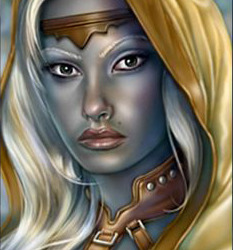
I guess that’s why I went with a drow for that top picture. Anyone who’s played Baldur’s Gate 1&2 will know Viconia spends a loooot of time raising skeletons. It just seems fitting.
3 notes
·
View notes
Text
The peace domain
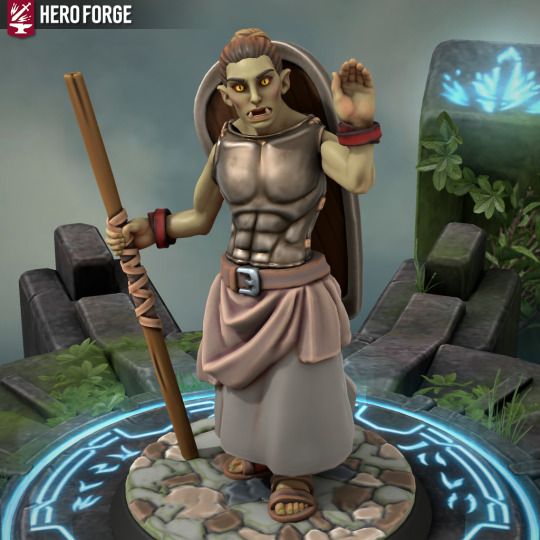
It might be a little naughty to say but I wonder if this domain might be intended to replace the life domain. Both domains are focused on keeping other party members alive and have that ‘party mum’ vibe that gets thrown around about clerics, however the life domain is... kind of boring. Everything it does just makes a cleric better at healing, and it really shoehorns a cleric into just healing the party.
The peace domain is much more interesting. At first level they gain emboldening bond, a feature that for ten minutes allows their allies to add a D4 to an attack roll, ability check or saving throw once per turn. This is great because it allows your allies to decide how they want to benefit from the feature. It’s also preemptive, rather than responsive like healing, which seems a little more fun. Also, domain spells like heroism and aid which add hit points, and warding bond which grants damage resistance, all contribute to making the party more resilient, but again, act preemptively.
Of course these clerics do have access to healing spells, as well as a channel divinity option that allows them to heal as many allies as they can reach in one turn’s movement.
At higher levels, emboldening bond becomes protective bond and allows party members to teleport next to their allies and take damage for them when they’ve just been hit, again, involving other party members in the process of keeping the party alive, which I think is just a really nice touch.
This domain would work really well for any deities that have the life domain suggested for them. Eldath, Lathander, Ilmater and Sune in the Forgotten Realms, and Boldrei in particular in Eberron. If you’re wanting to play a cleric focused on keeping the party alive, the peace domain will prove a little more complicated than the life domain, but will likely be more interesting and rewarding as well.
1 note
·
View note
Text
The order domain

This is one of my favourites. I mentioned before that I really like playing characters that focus on buffing allies because you can help them bring out their best and that’s just a nice feeling, and the order domain does that really well.
From level one, when you target an ally with a spell, say cure wounds, healing word, heroism or bless, you can allow that ally to make an attack with their reaction. The damage dealers in your party are going to love you for this. Later you can cast enchantment spells as bonus actions, making bless and heroism even more useful, however this also allows you to cast hold person, compulsion and dominate person as bonus actions.
I like the idea of sitting back out of harm’s way supporting allies with buffs and doing damage at range with cantrips or a light crossbow. The channel divinity option could help with this, as it allows you to charm a group of enemies, meaning they can’t target you.
You might be tempted to swap out divine strikes for blessed strikes given the lack of martial weapon proficiency, but this domain’s 17th level ability allows an ally to deal extra psychic damage to enemies you target with your divine strike, so boosting your cantrips might be ultimately more effective, but if you’re expecting to get to level 17, sticking with divine strikes supports the feel of this domain a bit better.
Order domain deities run the gamut of lawful alignments, and this playstyle works well for all of them, although the good ones like Bahamut, Torm and Tyr might lean more towards buffing allies, while the evil ones might lean towards holding and dominating enemies, and approach spells like bless and heroism with a very bossy tone. Clerics of neutral deities like Helm and Amaunator will likely draw a path between the two styles. All in all I love this domain.
3 notes
·
View notes
Text
The grave domain

This is a nice, sensible domain. It’s designed for standing back at a respectable distance, alternating between debuffing enemies, healing allies who are near death, and doing a respectable amount of cantrip damage. They can also spend time buffing allies if you want.
The toll the dead cantrip is very much in keeping with the theme of the domain, and they conveniently get potent spellcasting to make it a bit better. Their domain spells include vampiric touch and blight, both of which do a lot of damage. Other domain spells include bane, ray of enfeeblement and antilife shell, all useful debuff or control spells. Circle of mortality also makes their healing spells very useful for preventing allies from dying.
Their path to the grave channel divinity option allows you to give one enemy vulnerability to the next attack that hits it, doubling the damage dealt. This is really useful in conjunction with an ally who does single high damage attacks, like a rogue. If you make sure the ally who does a lot of damage is the next to attack a creature after this is activated you can let them do quite a lot of damage. (note that for an action to be an attack it must include an attack roll, so spells that require saves don’t count) If neccessary you could ready an action to have path to the grave go off just before the ally attacks.
This domain is a nice alternative to the death domain for clerics of deities invested in maintaining the order of life and death, like Kelemvor and Urogalan, it utilises necromancy spells in a fashion that’s in keeping with the natural order.
2 notes
·
View notes